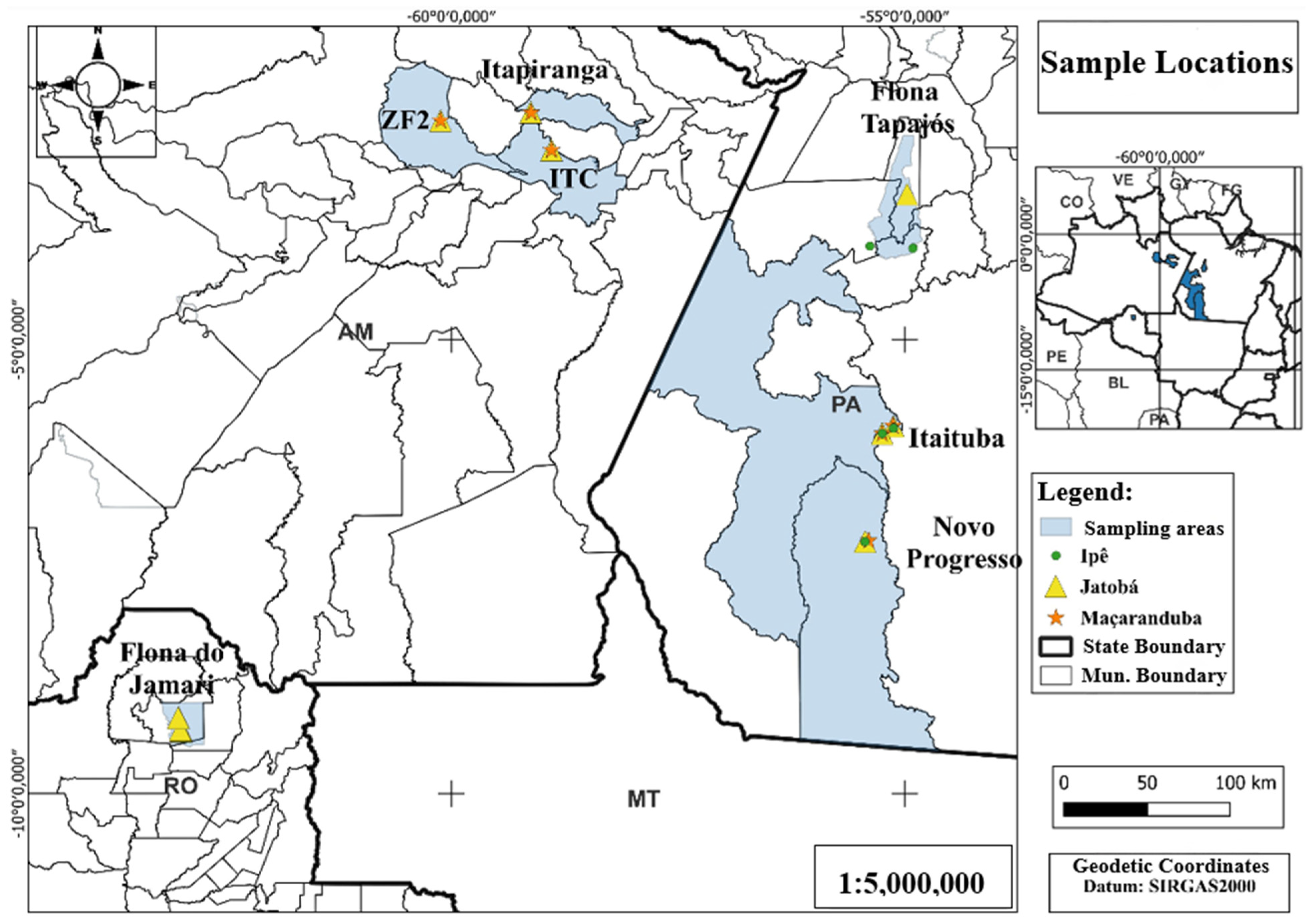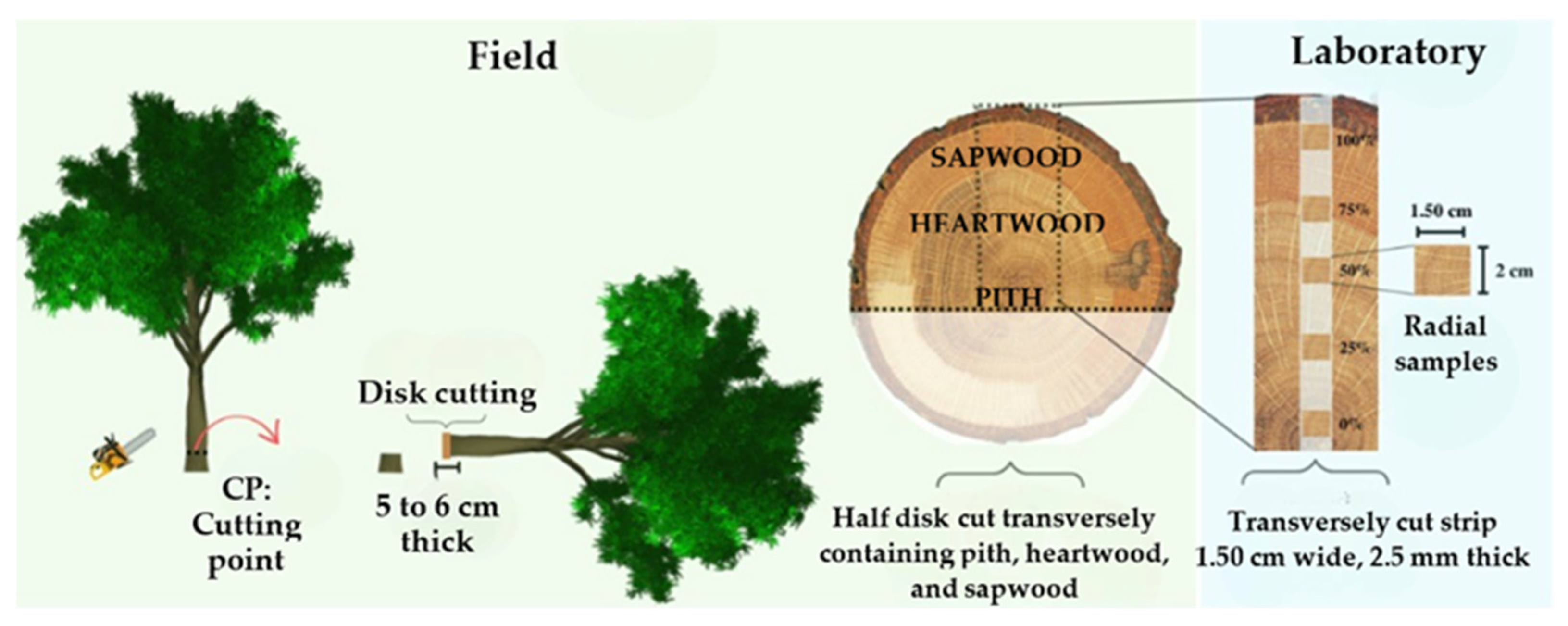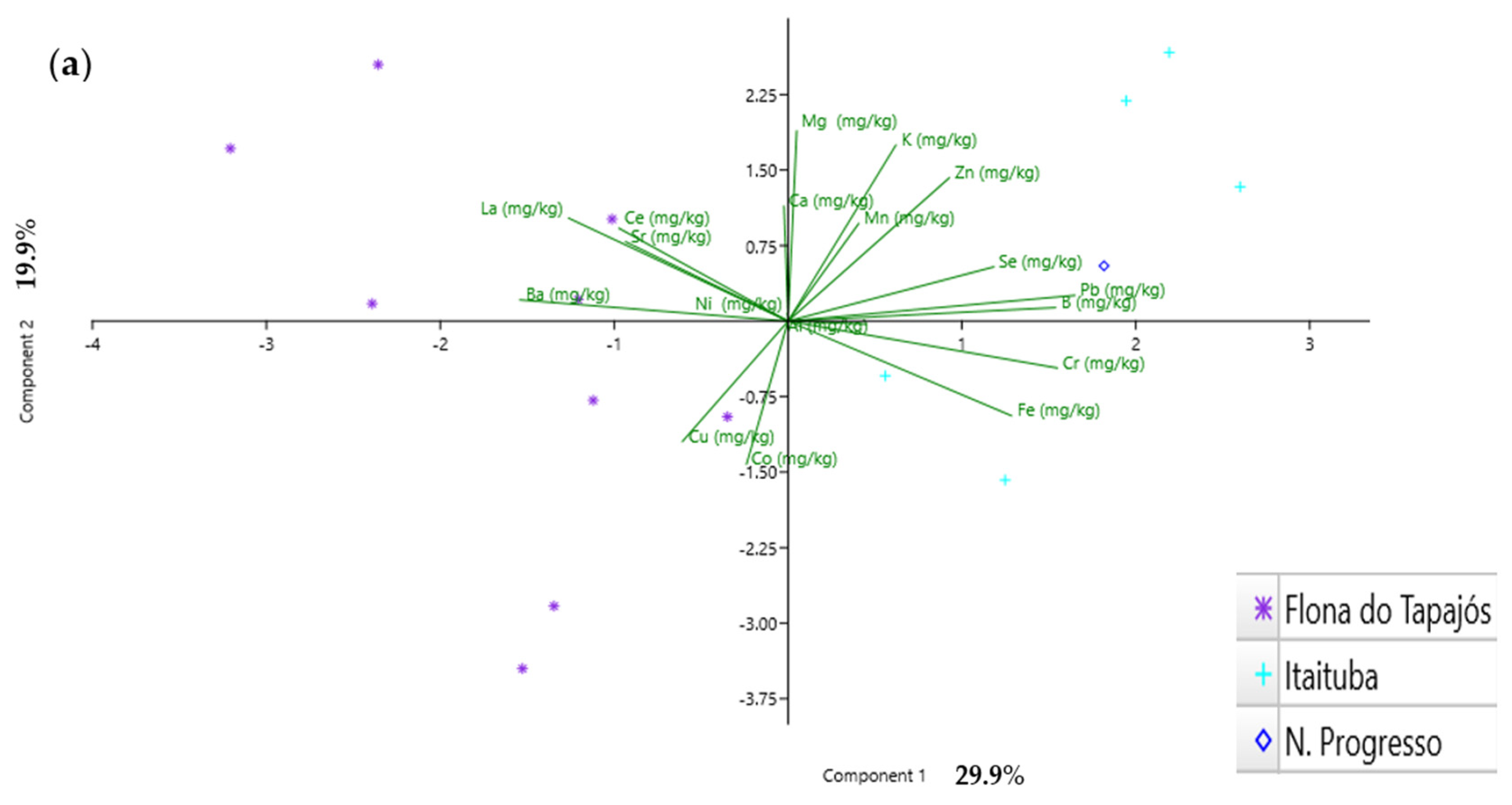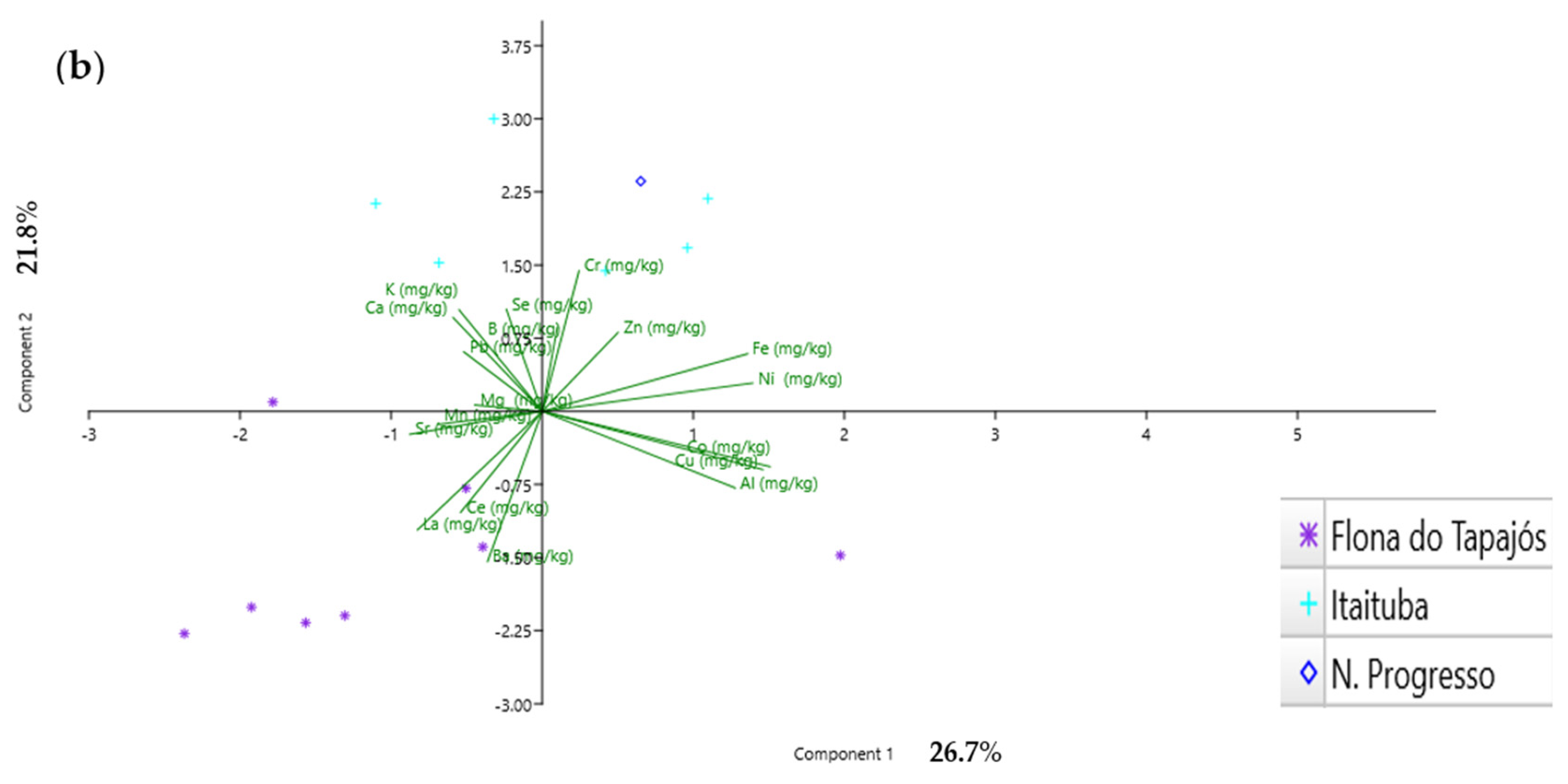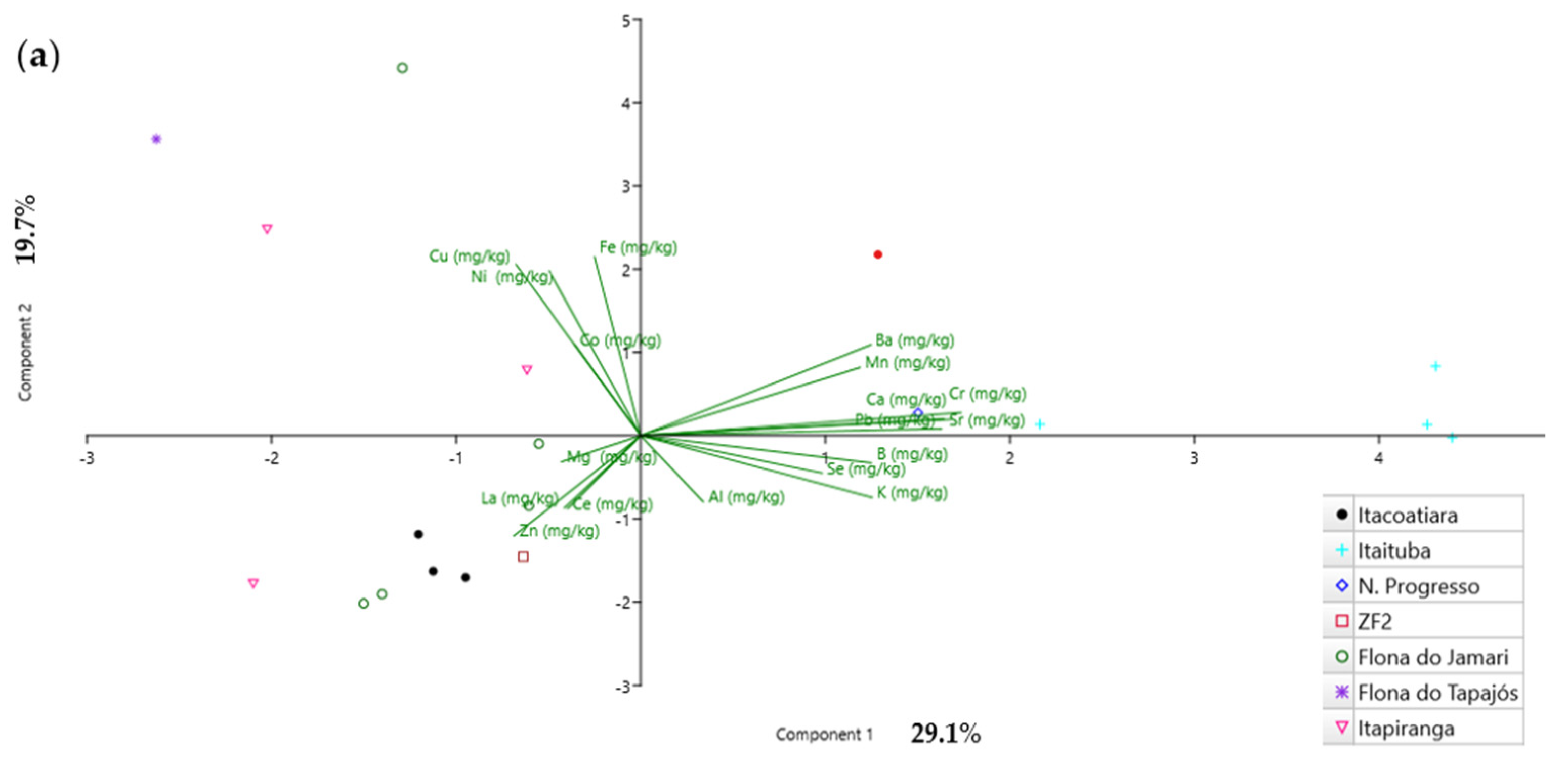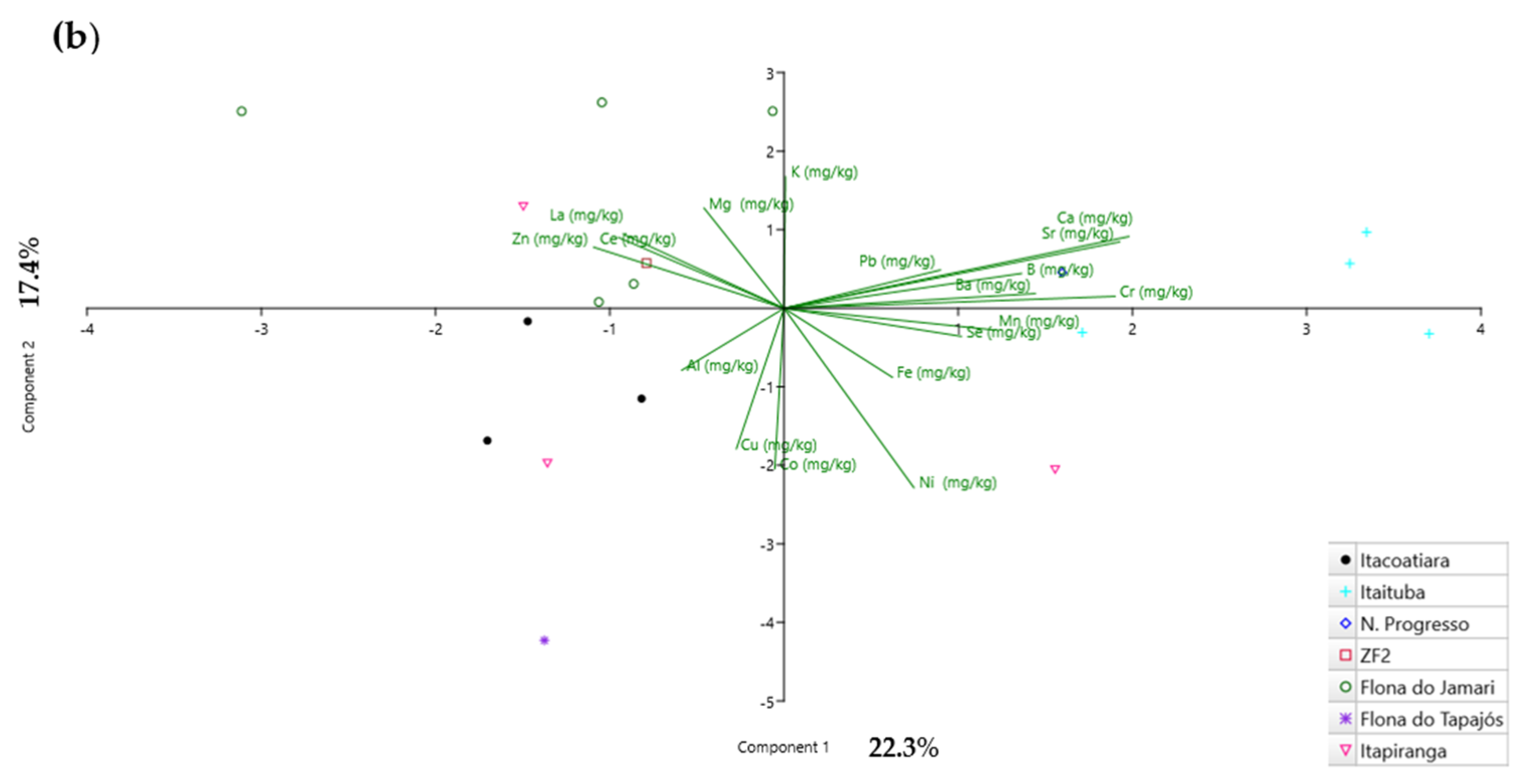1. Introduction
The irrational exploitation of timber has led to the reduction in natural forest areas and biodiversity, as well as contributed to increased greenhouse gas emissions. The Amazon rainforest plays a crucial role in maintaining biological diversity and regulating the climate, particularly in terms of carbon storage and CO
2 sequestration, as well as influencing rainfall patterns [
1]. However, the loss of primary native forests has increased annually, with logging activity emerging as a major driver of Amazon forest degradation. It is important to note that, like other less-studied anthropogenic disturbances, selective logging also threatens the future of tropical forests [
2]. The devastation is exacerbated by inadequate and illegal logging practices [
3].
Despite the predatory activity observed in certain managed and unauthorized areas, the forestry sector in the Legal Amazon is significant for both the regional and national economy, as Brazil ranks fourth among the largest wood producers. Pará and Mato Grosso stand out in producing tropical roundwood, ranking behind Indonesia, India, and Vietnam [
4].
Control mechanisms and efforts to combat illegal logging have not effectively curbed fraud in the production chain, since determining the origin of timber proves to be a complex task—especially in unintegrated supply chains that rely solely on documentation to prove origin [
5].
In recent years, determining timber origin based on its chemical fingerprint has emerged as a potential forensic tool for monitoring and controlling illegal timber trade [
6]. Certain inorganic elements present in the soil are incorporated into plant tissues through their physiological processes.
The Amazon exhibits a wide variability of soil classes according to the Brazilian Soil Classification System (SiBCS), with a predominance of highly weathered, acidic, and nutrient-poor Oxisols, Ultisols, and Entisols. Even in these deep profiles, regional geochemical studies have shown that the elemental signature of the parent material is still detectable in the soil matrix, creating pedogeochemical mosaics that can be distinguished at the landscape scale [
7].
Multi-elemental analysis for origin determination relies on the absorption of chemical elements by an organism, which is directly related to the quantity of these elements in the soil [
8]. Thus, the trace elements in wood can provide a chemical fingerprint for tracking timber products, presenting a promising new method [
9].
This method involves quantifying a large set of elements after organic material digestion, measured simultaneously using analytical techniques such as Inductively Coupled Plasma Mass Spectrometry (ICP-MS). This chemical profile provides a site-specific “fingerprint” to enable geographic origin verification [
9].
Elemental composition-based methods have shown potential in distinguishing regions, as observed by Deklerck et al. [
10], who demonstrated it was possible to separate the country of origin (Democratic Republic of Congo or Côte d’Ivoire) for
Terminalia superba. Moreira et al. [
11] also observed that the chemical profiles of Ipê species showed significant differences between species and wood tissues, indicating that multi-elemental profiling has great potential as a forensic tool. Ng et al. [
12] concluded that tools verifying the origin of merbau (
Intsia palembanica Miq) timber are valuable for aiding investigations and providing evidence in legal proceedings.
Therefore, this study aims to develop a wood tracing tool based on multi-elemental analysis of three tree species from the Brazilian Legal Amazon to verify whether there are significant differences in elemental concentrations between different locations for the same species. A satisfactory outcome would support the adoption of this tool by forensic institutes and regulatory agencies (environmental, police, and agricultural defense, among others) across Brazilian states, strengthening physical evidence in criminal proceedings, supporting scientifically based judgments, and avoiding subjectivity and errors.
2. Materials and Methods
2.1. Sample Collection and Preparation
The species analyzed were
Jatobá (
Hymenaea courbaril L.), with 18 samples collected from 7 locations (Jamari National Forest, Tapajós National Forest, Itacoatiara, Itaituba, Itapiranga, Novo Progresso, and ZF2);
Ipê (
Handroanthus sp.), with 16 samples from 3 locations (Tapajós National Forest, Itaituba, and Novo Progresso); and
Maçaranduba (
Manilkara huberi (Ducke) A. Chevalier)), with 11 samples from 5 locations (Itacoatiara, Itaituba, Itapiranga, Novo Progresso, and ZF2), as shown in
Figure 1. All samples came from licensed Forest Management Plans, located on private lands and in areas of public forest concessions (National Forests). The dataset containing information about the samples studied is available at Environmental Isotope Studies, EIS (2025), “Data for: Amazon Multi-Elemental Timber Analysis”, Mendeley Data, V1, doi: 10.17632/7st9ccr2cw.1
The samples were obtained from the following soil classes: PVAd—Dystrophic Red-Yellow Argisol (PMFs Novo Progresso and Itaituba, Flona do Tapajós) and LAd—Dystrophic Yellow Latosol (ZF2, Flona Jamari, and PMFs of Itacoatira and Itapiranga).
Five subsamples, each measuring 1.5 cm in width and 2.2 mm in thickness, were taken across the radius of each wood disk (from sapwood, heartwood, and pith), obtained from the base of the trunk (40 cm above ground level), at 0%, 25%, 50%, 75%, and 100% of the radial extension for each selected tree (
Figure 2).
Representative wood disks from each species were cut transversely using a circular saw to obtain wood slices. These slices were ground using a RETSCH MM 400 vibration mill (Haan, Germany), and aliquots ranging from 0.023 g to 0.027 g were subjected to chemical digestion for subsequent elemental analysis via Inductively Coupled Plasma Mass Spectrometry (ICP-MS).
2.2. Elemental Analysis
Calibration analytical solutions were prepared from diluted aliquots of single-element stock solutions containing 1000 mg L−1 of Mg, B, Al, K, Ca, Cr, Mn, Fe, Co, Ni, Cu, Sr, Zn, Se, Ba, La, Ce, and Pb (Sigma-Aldrich, Darmstadt, Germany) in 0.14 mol L−1 HNO3. Yttrium (Y) was used as the internal standard at 250 µg L−1 concentration in all samples, blanks, and analytical curves. The certified reference material (CRM) NIST 1573a, tomato leaves, was used to validate the applied methodology.
Element determination was performed using an ICP-MS, model 7700 from Agilent Technologies (Tokyo, Japan), operated in collision cell mode using helium gas (99.995%) and Argon (99.999%) from White Martins-Praxair.
2.3. Statistical Analysis
Due to the subdivision of the samples based on the radial portions, the elemental concentrations were statistically analyzed for all five portions (0%, 25%, 50%, 75%, and 100%) individually, and using the mean values of all portions. This approach aimed to investigate significant differences and determine which dataset (individual or mean values for each wood portion) provided better origin discrimination.
Basic statistical characteristics (mean, standard deviation) were determined using descriptive statistics.
The non-parametric Kruskal–Wallis test was used to compare statistical differences between tree species samples for each chemical element. The Dwass–Steel–Critchlow–Fligner test (non-parametric post hoc) verified significant differences among groups. Additionally, Principal Component Analysis (PCA) was used to explain the data by reducing variables and identifying distinct groups. PCA was applied to the Jatobá, Ipê, and Maçaranduba datasets for all five radial portions and the mean of these portions.
Data were processed using JAMOVI software version 2.3.21 and PAST software version 4.12b. The applied tests considered a significance level of 5%.
3. Results
The Kruskal–Wallis test revealed significant differences, for the analyzed species in all disk portions (except for Maçaranduba, which showed significant difference only at the 25% radial portion), between locations based on elemental concentrations in the samples (
Table S1,
Supplementary Materials). When applying the Dwass–Steel–Critchlow–Fligner post hoc test, a significant difference between locations was observed only for Ipê samples between Tapajós National Forest and Itaituba (for each radial position and for the mean of all positions—
Table 1). Pairwise comparisons between Tapajós National Forest and Novo Progresso and between Itaituba and Novo Progresso, did not show significant differences at the predetermined significance level (
p < 0.05).
Principal Component Analysis (PCA) allowed the visualization of the elemental profile distribution of samples of each species by location. Further details regarding these PCAs are provided in
Figure S1 (Maçaranduba),
Figures S2 and S3.
For Ipê, geographic differentiation was observed between samples from Tapajós National Forest and Itaituba when using the mean values of the disk portions (
Figure 3a) and the 100% portion (
Figure 3b). It is noteworthy that the single Ipê sample from Novo Progresso stood out from those from Tapajós National Forest, although insufficiently to conclude geographic discrimination, as the analysis of all samples (across species) from Novo Progresso versus Tapajós National Forest did not show clear location separation.
For Jatobá, both the mean of disk radial positions (
Figure 4a) and the 25% position (
Figure 4b) provided location discrimination, enabling provenance distinction. In both PCA scenarios, spatial separation of samples from Itacoatiara and Itaituba, and from Jamari National Forest and Itaituba was observed.
In the PCA for the 25% radial portion, the most relevant elements for distinguishing Itaituba from Itacoatiara were Ca, Sr, Cr, and Ba. Conversely, La, Zn, and Ce contributed to the separation of Itacoatiara samples from Itaituba. A strong positive correlation was observed between Ca and Sr for Jatobá. In contrast, these elements showed negative correlation with Cu and Ni, suggesting that soils rich in these metals are poor in Ca and Sr.
Similar to Jatobá, PCA results for Maçaranduba also showed that the mean of the radial positions (
Figure 5a) and the 25% portion (
Figure 5b) enabled geographic discrimination of the sample locations.
For Maçaranduba, PCA based on the mean of the positions yielded better results than the one based on the 25% portion, as it allowed a clear distinction among three geographic locations (Itapiranga, Itacoatiara, and Itaituba), while the 25% portion analysis only discriminated between two (Itacoatiara and Itaituba). As seen with Jatobá, a strong positive correlation between Ca and Sr was also observed for Maçaranduba.
4. Discussion
Regarding the mean concentrations of elements, Itaituba stood out with higher average values for most elements—especially K, Ca, Cr, Mn, Fe, and Zn—in the samples of the three analyzed species. This suggests a strong edaphic influence, with soils that are more enriched or have greater bioavailability of these elements.
The Kruskal–Wallis test indicated that the greatest number of significant differences in element concentrations between locations occurred in the Ipê samples, suggesting environmental heterogeneity in the areas where the samples were collected.
The results showed that multi-elemental analysis was effective in differentiating the geographic origin of Ipê, Jatobá, and Maçaranduba wood samples from various Amazonian locations, especially when using either the mean of the radial portions or the 25% portion of the disk radius. The PCA using the mean of the portions separated the Jatobá and Maçaranduba samples into three distinct geographic groups. The 25% portion, in turn, allowed better location discrimination for Maçaranduba and Jatobá, forming two groups. For Ipê, two distinct groupings were observed in the PCA results using the mean and the 100% portion of the disk.
This distribution may be linked to specific soil characteristics, as the elements analyzed occur naturally in the Earth’s crust and are made available through weathering processes [
13]. The formation of distinct PCA groups reinforces the discriminative potential of multi-elemental analysis, corroborating findings by Rees [
14] and highlighting the utility of elemental profiling in identifying the origin of tropical timber.
Although PCA results for Maçaranduba samples showed the distinction between Itacoatiara and Itapiranga for both the mean and the 25% disk portion, the soils in both areas belong to the same classification. The observed differentiation may be explained by the fact that wood chemical composition reflects the soil type, local geochemical dynamics, and environmental interactions. DEKLERCK et al. [
10] demonstrated that it was possible to separate countries of origin (Democratic Republic of Congo or Côte d’Ivoire) for
Terminalia superba trees growing in very similar soils. The elements that contributed to separating Maçaranduba samples from Itapiranga versus Itacoatiara were Co and Cu. The higher concentrations of these elements in Itapiranga may result from Haplic Cambisols—less weathered soils with higher levels of Co and Cu. According to Suppi et al. [
15], young soils such as Cambisols have higher Co and Mn contents than more weathered soils like Oxisols, even if derived from the same parent material.
However, when PCA was applied across all three species and their respective localities, there was no clear separation between Itapiranga and Itacoatiara, likely due to the larger data volume from multiple species analyzed together (
Figure S4). Restricting the analysis to a single species resulted in distinct groupings, suggesting that species-specific factors also play a role in geographic discrimination.
In the case of Ipê, distinct groupings were observed in PCA between Tapajós National Forest and Itaituba. Intra- and interspecific variation can occur even in sites with similar soils. In a recent study, Moreira et al. [
11] observed interspecies differences among Ipê species, consistent with findings showing significant chemical composition variation among co-occurring species due to genetic and ecological differences. Another possible explanation for the observed separation among Ipê samples in similar soil classes is the variation gradient within the Red-Yellow Argisol, which includes Quartzarenic Neosols and Petric Plinthosols in Itaituba. These latter soil types are rich in Al and Fe, contributing to the separation between Tapajós and Itaituba groups.
For Jatobá, both the average values and the 25% disk portion allowed the separation of Itaituba samples from those of Itacoatiara and Jamari National Forest. The elements responsible were Chromium (Cr), Strontium (Sr), Calcium (Ca), and Barium (Ba), with higher concentrations found in Itaituba samples.
The correlation between Sr and Ca observed in both Jatobá and Maçaranduba samples is consistent with Kabata-Pendias [
16], who highlighted the geochemical similarity of these elements, which are often associated with more weathered soils. Sr shares geochemical and biochemical behavior with Ca, and during weathering, its chelated forms play an important role in biogeochemical cycling closely linked to Ca. Therefore, Sr is often associated with Ca.
These findings show that variability in wood elemental composition across species is largely influenced by specific soil characteristics, as environmental elemental abundance helps differentiate the geographic origin of timber species. These elements naturally occur in the Earth’s crust and become available through weathering, influencing their wood distribution. This observation is supported by Boeschoten et al. [
9], who found that elemental composition of soil, sapwood, and heartwood are significantly associated, providing the basis for wood origin verification.
The intermediate disk portions (25% to 75%), and especially the average of all five sampled portions, proved most effective in geographic discrimination. The 0% (near the pith) and 100% (outer bark) portions showed lower discriminative ability, which has practical implications, since these portions are often absent in processed lumber. These patterns align with the sapwood–heartwood transition dynamics and differential accumulation of elements, as described by Meerts [
17] and Smith et al. [
18].
Elements such as Cu, Co, Zn, Ca, and B, which had lower concentrations in the heartwood (between 25% and 75% of the disk radius) and contributed to locality distinction, are frequently mobilized and redistributed during tree growth and heartwood formation. As sapwood transitions into heartwood, compounds are translocated in a manner similar to foliar senescence, where translocatable and mobile mineral elements are moved from senescing sapwood to younger, physiologically active sapwood [
19]. Moreira et al. [
11] stated that such variations highlight specific characteristics within and among individuals that contribute to overall data variability, confirming that both species and wood tissues differ.
5. Conclusions
The results of this study demonstrate that multi-elemental analysis, combined with Principal Component Analysis (PCA), is a promising tool for determining the geographic origin of tropical timber species in the Brazilian Legal Amazon. Regional differentiation was made possible especially when considering the mean of the radial portions and the 25% portion of the trunk radius, which showed the greatest discriminative power. The influence of the soil’s geochemical composition was evident, even though specific elements such as Cu, Co, Zn, Ca, and B stood out in distinguishing samples from different regions.
These findings reinforce the forensic potential of multi-elemental wood profiling as a complementary tool to traditional documentation-based traceability systems, with direct implications for controlling illegal logging and strengthening environmental enforcement actions.
Therefore, we recommend expanding elemental databases for timber species and further studies with broader geographic and sample representation, aiming to consolidate this approach as a traceability instrument within the tropical timber production chain.
